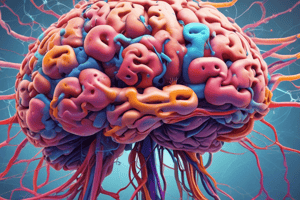Podcast
Questions and Answers
What type of neurons are primarily degenerated in Huntington's disease?
What type of neurons are primarily degenerated in Huntington's disease?
- Cholinergic neurons
- Dopaminergic neurons
- GABAergic neurons (correct)
- Serotonergic neurons
Which neurotransmitter is likely deficient in individuals exhibiting jerky involuntary movements?
Which neurotransmitter is likely deficient in individuals exhibiting jerky involuntary movements?
- Serotonin
- GABA (correct)
- Acetylcholine
- Dopamine
How often is Huntington's disease hereditary?
How often is Huntington's disease hereditary?
- Definitely (correct)
- Uncommonly
- Rarely
- Sometimes
If an individual has 119 CAG repeats in their DNA, how many CAG repeats are present in their protein?
If an individual has 119 CAG repeats in their DNA, how many CAG repeats are present in their protein?
What is the minimum number of CAG repeats associated with the manifestation of Huntington's disease?
What is the minimum number of CAG repeats associated with the manifestation of Huntington's disease?
What condition is characterized by the loss of dopaminergic neurons in the substantia nigra?
What condition is characterized by the loss of dopaminergic neurons in the substantia nigra?
Which of the following groups would be at the highest risk of developing Parkinson's Disease?
Which of the following groups would be at the highest risk of developing Parkinson's Disease?
What is the main neurotransmitter affected in Parkinson's Disease?
What is the main neurotransmitter affected in Parkinson's Disease?
Which of the following symptoms is NOT typically associated with Parkinson's Disease?
Which of the following symptoms is NOT typically associated with Parkinson's Disease?
In Parkinson's Disease, the role of environmental factors such as pesticides is best described as:
In Parkinson's Disease, the role of environmental factors such as pesticides is best described as:
Which disease is characterized by specific initial brain area degeneration affecting motor control?
Which disease is characterized by specific initial brain area degeneration affecting motor control?
Which cellular event is most commonly associated with Alzheimer's disease?
Which cellular event is most commonly associated with Alzheimer's disease?
What mutation type is involved in Huntington's disease?
What mutation type is involved in Huntington's disease?
Which behavior is commonly observed in a person with Parkinson’s disease?
Which behavior is commonly observed in a person with Parkinson’s disease?
How does organ donation relate to brain death in Singapore?
How does organ donation relate to brain death in Singapore?
Which disease is characterized by extracellular amyloid beta plaques and intracellular tau tangles?
Which disease is characterized by extracellular amyloid beta plaques and intracellular tau tangles?
Which factor is known to increase the risk of developing Alzheimer's Disease?
Which factor is known to increase the risk of developing Alzheimer's Disease?
What is the behavioral effect of motoneuron loss in Amyotrophic Lateral Sclerosis (ALS)?
What is the behavioral effect of motoneuron loss in Amyotrophic Lateral Sclerosis (ALS)?
Which group is likely to have the largest ventricles based on age and disease status?
Which group is likely to have the largest ventricles based on age and disease status?
Which of the following neurodegenerative diseases is known for causing the loss of motor neurons?
Which of the following neurodegenerative diseases is known for causing the loss of motor neurons?
When comparing brain tissue across different conditions, which group is expected to have the most brain tissue?
When comparing brain tissue across different conditions, which group is expected to have the most brain tissue?
How hereditary is Amyotrophic Lateral Sclerosis (ALS) in known cases?
How hereditary is Amyotrophic Lateral Sclerosis (ALS) in known cases?
Which area of the brain is primarily affected first in Alzheimer's Disease?
Which area of the brain is primarily affected first in Alzheimer's Disease?
Flashcards
Alzheimer's disease brain areas affected
Alzheimer's disease brain areas affected
Initially affects areas responsible for memory and cognitive functions, such as the hippocampus and cortex.
Amyotropic Lateral Sclerosis (ALS) initial brain areas
Amyotropic Lateral Sclerosis (ALS) initial brain areas
Initially affects motor neurons, leading to progressively debilitating muscle weakness and loss of function.
Huntington's Disease initial brain area
Huntington's Disease initial brain area
Initiates in areas controlling movement, emotion, and cognition, leading to uncontrolled movements, mood changes, and cognitive decline.
Parkinson's Disease initial brain area
Parkinson's Disease initial brain area
Signup and view all the flashcards
Brain death definition
Brain death definition
Signup and view all the flashcards
Neurodegeneration
Neurodegeneration
Signup and view all the flashcards
Alzheimer's Disease
Alzheimer's Disease
Signup and view all the flashcards
Amyloid plaques
Amyloid plaques
Signup and view all the flashcards
Tau tangles
Tau tangles
Signup and view all the flashcards
Amyotrophic Lateral Sclerosis (ALS)
Amyotrophic Lateral Sclerosis (ALS)
Signup and view all the flashcards
Behavioral effect of motor neuron loss
Behavioral effect of motor neuron loss
Signup and view all the flashcards
Genetic factors in Neurodegenerative diseases
Genetic factors in Neurodegenerative diseases
Signup and view all the flashcards
Brain ventricle size and Alzheimer's
Brain ventricle size and Alzheimer's
Signup and view all the flashcards
Huntington's Disease Cause
Huntington's Disease Cause
Signup and view all the flashcards
CAG Repeats & Disease Severity
CAG Repeats & Disease Severity
Signup and view all the flashcards
Neurotransmitter Imbalance in Huntington's
Neurotransmitter Imbalance in Huntington's
Signup and view all the flashcards
Huntington's Disease & Genetics
Huntington's Disease & Genetics
Signup and view all the flashcards
CAG Repeats to Glutamine Conversion
CAG Repeats to Glutamine Conversion
Signup and view all the flashcards
CAG repeats
CAG repeats
Signup and view all the flashcards
Parkinson's Disease: Key characteristic
Parkinson's Disease: Key characteristic
Signup and view all the flashcards
Dopamine's role in movement
Dopamine's role in movement
Signup and view all the flashcards
Parkinson's Disease: Symptoms
Parkinson's Disease: Symptoms
Signup and view all the flashcards
Genetic vs. Environmental in Parkinson's
Genetic vs. Environmental in Parkinson's
Signup and view all the flashcards
Study Notes
Learning Objectives
- Rank young, old, and Alzheimer's brains based on ventricle size and brain tissue volume
- Identify the initial brain regions affected by Alzheimer's disease, amyotrophic lateral sclerosis (ALS), Huntington's disease, and Parkinson's disease
- Describe how individuals with Alzheimer's disease, ALS, Huntington's disease, or Parkinson's disease behave
- Identify cellular events in the brains of individuals affected by Alzheimer's disease, ALS, Huntington's disease, or Parkinson's disease
- List the DNA and protein-level mutations causing Huntington's disease
- Predict the likelihood of a child inheriting ALS based on parental genotypes
Brain States and Function
- The provided infographic categorizes cognitive function states against motor function
- States range from fully conscious and aware to unresponsive and unaware
- Normal brain function is positioned in the complex, purposeful, and voluntary motor function section
- Brain death is placed at the absent motor function segment
- Coma, minimally conscious states, vegetative states are placed within the absent and reflex to complex motor function.
Singapore's Organ Donation Policy
- Upon brain death, the government takes ownership of individual organs
- An opt-out system exists, but the government assumes consent for organ donation
- This is unlike numerous other countries, often based on a concept of organ ownership after death
Questions about Death and Brain States
- Questions posed include: Is death a point or a spectrum?
- Who defines the point of death?
- Specific neuro-related terminology is written.
Neurological Diseases
-
Alzheimer's Disease: Characterized by extracellular amyloid beta plaques and intracellular tau tangles in neurons. Symptoms include memory loss and behavioral disturbances
-
Amyotrophic Lateral Sclerosis (ALS): A degenerative disease causing motor neuron loss in the spinal cord and brain stem.
-
Huntington's Disease: Characterized by chorea (involuntary movements). Degenerating neurons in the cortex and striatum (a brain region neighboring the substantia nigra). Mutant Huntingtin protein aggregates within neurons. The specific disease is caused by an extended repetition of CAG.
-
Parkinson's Disease: Characterized by the loss of dopaminergic neurons in the substantia nigra. Symptoms include resting tremor, postural instability, and gait disturbances. Parkinson's disease can be induced by a chemical. Environmental factors like pesticides may be a contributing factor in some cases
Genetics and Neurodegenerative Diseases
- Huntington's disease is linked to a specific repetition within a gene
- The number of repetitions predicts the development of Huntington's disease.
Studying That Suits You
Use AI to generate personalized quizzes and flashcards to suit your learning preferences.
Related Documents
Description
This quiz explores the differences in brain structure and function across various age groups and diseases such as Alzheimer's, ALS, Huntington's, and Parkinson's. Participants will rank brain conditions based on ventricle size, identify affected brain regions, and analyze genetic factors influencing these diseases.





